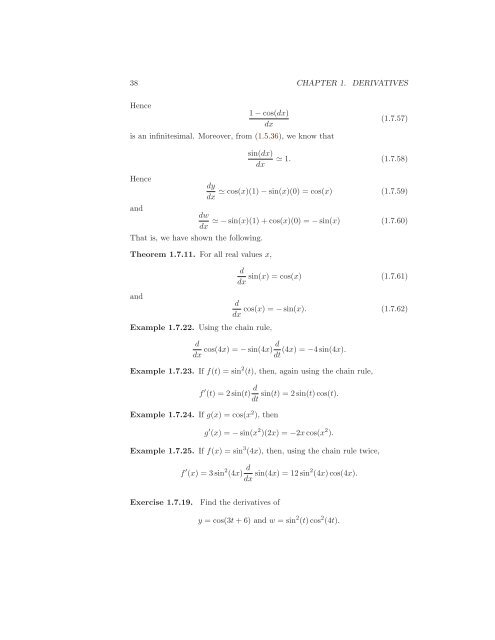Yet Another Calculus Text, 2007a
Yet Another Calculus Text, 2007a
Yet Another Calculus Text, 2007a
You also want an ePaper? Increase the reach of your titles
YUMPU automatically turns print PDFs into web optimized ePapers that Google loves.
38 CHAPTER 1. DERIVATIVES<br />
Hence<br />
1 − cos(dx)<br />
dx<br />
is an infinitesimal. Moreover, from (1.5.36), we know that<br />
(1.7.57)<br />
Hence<br />
sin(dx)<br />
dx<br />
≃ 1. (1.7.58)<br />
dy<br />
≃ cos(x)(1) − sin(x)(0) = cos(x) (1.7.59)<br />
dx<br />
and<br />
dw<br />
≃−sin(x)(1) + cos(x)(0) = − sin(x) (1.7.60)<br />
dx<br />
Thatis,wehaveshownthefollowing.<br />
Theorem 1.7.11. For all real values x,<br />
d<br />
sin(x) =cos(x) (1.7.61)<br />
dx<br />
and<br />
d<br />
cos(x) =− sin(x). (1.7.62)<br />
dx<br />
Example 1.7.22. Using the chain rule,<br />
d<br />
dx cos(4x) =− sin(4x) d (4x) =−4sin(4x).<br />
dt<br />
Example 1.7.23. If f(t) =sin 2 (t), then, again using the chain rule,<br />
f ′ (t) =2sin(t) d sin(t) =2sin(t) cos(t).<br />
dt<br />
Example 1.7.24. If g(x) =cos(x 2 ), then<br />
g ′ (x) =− sin(x 2 )(2x) =−2x cos(x 2 ).<br />
Example 1.7.25. If f(x) =sin 3 (4x), then, using the chain rule twice,<br />
f ′ (x) =3sin 2 (4x) d<br />
dx sin(4x) = 12 sin2 (4x)cos(4x).<br />
Exercise 1.7.19.<br />
Find the derivatives of<br />
y =cos(3t +6)andw =sin 2 (t)cos 2 (4t).


















